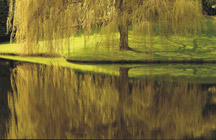
The Revolution Hits America
When Johns Hopkins died in 1873, he left a large trust
to found a university and hospital. His trustees, seeing the numbers of American
medical students who were studying in Europe, decided (against the advice of the
most well-known educators of the day) to model the university after the great
German universities. It was at those universities that open inquiry and research
were not just allowed, but demanded, and where students were expected to meet
strict entrance requirements, something unknown in any American medical
institution. The trustees intended to create an institution that would be as
rigorous as its European counterparts.
After its founding in 1876, the new president of Johns Hopkins University began assembling an international faculty, and the school started modestly by offering graduate courses. In 1884 William Welch was hired to found and run the medical school. The medical school itself would not open for nine more years, but the Pathological Laboratory opened right away. And almost immediately, American medicine was transformed, and Welch would eventually become one of the most (if not the most) influential scientists in the world.
Welch had trained as a doctor and studied extensively in Germany. He had worked with and studied under the greatest scientists in Europe, and at a young age (he was only 34 when offered his position at Hopkins) he was already highly regarded in the profession. And more importantly, he had also developed contacts and friendships across the scientific world. He was not a great researcher - over his career he made only minor contributions to the field - but he had a rare gift to inspire trust and loyalty from almost everyone he came into contact with, and he had impeccable judgement, both about science and about people.

William Welch
Knowing that this was available, students flocked to Hopkins. Their entrance requirements were strict, unheard of in America, but students arrived in droves anyway. It was the place everyone wanted to be. It also became the place that every trustee at every competing university wanted to (or was forced to) emulate. Their graduates and researchers were in demand - some hospitals would only hire Hopkins-trained doctors. Of the first four Nobel laureates in medicine or physiology, three were trained at Hopkins (the fourth was trained in Europe). Hopkins graduates would move on to run medical schools at Harvard, Yale, Columbia, Rochester, and others, and would transform them to Hopkins standards.
Welch was the driving force behind all this, and he continued to press for change. He began directing the flow of millions of dollars into research to laboratories and researchers he deemed worthy. One of his protégés would spearhead the effort to force minimum standards on medical schools and on physicians themselves. Within 25 years of accepting his post at Johns Hopkins, Welch would have overseen the transformation of medicine in this country, and that transformation allowed the American scientific community to catch up with and in some areas surpass their colleagues in Europe.
Meanwhile, the assault on infectious diseases continued in laboratories across Europe, and real results were appearing. The germ theory had opened the floodgates for researchers. In 1880 Pasteur successfully vaccinated animals against cholera, then anthrax. Cholera and typhoid were being contained for the first time, based on an understanding of how they spread. Then finally, in 1891 in Berlin, researchers successfully cured a patient suffering from diphaitheria using an antitoxin. It was the first actual cure of the new era. Researchers in New York City learned how to mass-produce the antitoxin, and it became widely available. Doctors now had an actual tool to prevent and cure deadly disease. It would be the first of many.
The field of medicine was now a science, and the reductionist revolution was nearly complete. Its successes were created in the laboratory (and increasingly in the operating theatre as well). The fields of pathology, epidemiology, chemotherapy, forensic science, bacteriology, were all exploding. The battleground of medicine had moved from the physician's office to the laboratory.
The magnitude of the paradigm change from the days of Hippocratic thought was stunning. For two millennia, health was understood to be a reflection of balance at a systemic level. Now the focus had shifted from the macro to the micro, from the whole system to the minute parts. Reductionism was the order of the day, and Hippocrates had given way almost completely to Descartes. Medicine was now a study of tiny things, the smaller pieces of the machine, that could only be seen with help. The microscope was the most powerful tool in the researchers arsenal, and it symbolized the shift - it brought the world of tiny things to light. The modern cures were imparted from the outside, aimed to do battle with the microscopic, external invaders that attacked the body.
And research was where the action was. The next big development would involve the research institution that would become a model for the scientific world. In 1901, overseen by William Welch, the Rockefeller Institute for Medical Research was founded.
